Study 4: Extroversion Data Analysis
Model 1 Results
R. Noah Padgett
2022-01-17
Last updated: 2022-01-20
Checks: 4 2
Knit directory: Padgett-Dissertation/
This reproducible R Markdown analysis was created with workflowr (version 1.6.2). The Checks tab describes the reproducibility checks that were applied when the results were created. The Past versions tab lists the development history.
Great job! The global environment was empty. Objects defined in the global environment can affect the analysis in your R Markdown file in unknown ways. For reproduciblity it’s best to always run the code in an empty environment.
The command set.seed(20210401) was run prior to running the code in the R Markdown file. Setting a seed ensures that any results that rely on randomness, e.g. subsampling or permutations, are reproducible.
Great job! Recording the operating system, R version, and package versions is critical for reproducibility.
- model1
- study4-model1-ppd
To ensure reproducibility of the results, delete the cache directory study4_model1_results_cache and re-run the analysis. To have workflowr automatically delete the cache directory prior to building the file, set delete_cache = TRUE when running wflow_build() or wflow_publish().
Great job! Using relative paths to the files within your workflowr project makes it easier to run your code on other machines.
Tracking code development and connecting the code version to the results is critical for reproducibility. To start using Git, open the Terminal and type git init in your project directory.
This project is not being versioned with Git. To obtain the full reproducibility benefits of using workflowr, please see ?wflow_start.
# Load packages & utility functions
source("code/load_packages.R")
source("code/load_utility_functions.R")
# environment options
options(scipen = 999, digits=3)Describing the Observed Data
# Load diffIRT package with data
library(diffIRT)
data("extraversion")
mydata <- na.omit(extraversion)
# separate data then recombine
d1 <- mydata %>%
as.data.frame() %>%
select(contains("X"))%>%
mutate(id = 1:n()) %>%
pivot_longer(
cols=contains("X"),
names_to = c("item"),
values_to = "Response"
) %>%
mutate(
item = ifelse(nchar(item)==4,substr(item, 3,3),substr(item, 3,4))
)
d2 <- mydata %>%
as.data.frame() %>%
select(contains("T"))%>%
mutate(id = 1:n()) %>%
pivot_longer(
cols=starts_with("T"),
names_to = c("item"),
values_to = "Time"
) %>%
mutate(
item = ifelse(nchar(item)==4,substr(item, 3,3),substr(item, 3,4))
)
dat <- left_join(d1, d2)Joining, by = c("id", "item")dat_sum <- dat %>%
select(item, Response, Time) %>%
group_by(item) %>%
summarize(
M1 = mean(Response, na.rm=T),
Mt = mean(Time, na.rm=T),
SDt = sd(Time, na.rm=T),
Mlogt = mean(log(Time), na.rm=T),
)
colnames(dat_sum) <-
c(
"Item",
"Proportion Endorsed",
"Mean Response Time",
"SD Response Time",
"Mean Log Response Time"
)
kable(dat_sum, format = "html", digits = 3) %>%
kable_styling(full_width = T)| Item | Proportion Endorsed | Mean Response Time | SD Response Time | Mean Log Response Time |
|---|---|---|---|---|
| 1 | 0.739 | 1.488 | 0.805 | 0.288 |
| 10 | 0.866 | 0.979 | 0.520 | -0.115 |
| 2 | 0.535 | 1.354 | 0.648 | 0.208 |
| 3 | 0.852 | 1.115 | 0.632 | 0.002 |
| 4 | 0.923 | 1.001 | 0.664 | -0.114 |
| 5 | 0.542 | 1.301 | 0.706 | 0.163 |
| 6 | 0.901 | 1.255 | 0.682 | 0.119 |
| 7 | 0.944 | 1.143 | 0.546 | 0.054 |
| 8 | 0.965 | 1.067 | 0.575 | -0.030 |
| 9 | 0.824 | 1.728 | 0.745 | 0.463 |
# covariance among items
kable(cov(mydata[,colnames(mydata) %like% "X"]), digits = 3) %>%
kable_styling(full_width = T)| X[1] | X[2] | X[3] | X[4] | X[5] | X[6] | X[7] | X[8] | X[9] | X[10] | |
|---|---|---|---|---|---|---|---|---|---|---|
| X[1] | 0.194 | -0.001 | 0.039 | 0.029 | 0.000 | 0.002 | 0.014 | 0.005 | 0.011 | 0.015 |
| X[2] | -0.001 | 0.251 | 0.023 | 0.006 | 0.077 | 0.011 | 0.002 | 0.012 | 0.031 | 0.030 |
| X[3] | 0.039 | 0.023 | 0.127 | 0.038 | 0.024 | 0.028 | 0.020 | 0.016 | 0.016 | 0.051 |
| X[4] | 0.029 | 0.006 | 0.038 | 0.072 | 0.014 | 0.006 | 0.017 | 0.019 | 0.029 | 0.025 |
| X[5] | 0.000 | 0.077 | 0.024 | 0.014 | 0.250 | 0.004 | 0.017 | 0.005 | 0.032 | 0.031 |
| X[6] | 0.002 | 0.011 | 0.028 | 0.006 | 0.004 | 0.090 | 0.009 | 0.011 | 0.004 | 0.015 |
| X[7] | 0.014 | 0.002 | 0.020 | 0.017 | 0.017 | 0.009 | 0.054 | 0.019 | 0.004 | 0.007 |
| X[8] | 0.005 | 0.012 | 0.016 | 0.019 | 0.005 | 0.011 | 0.019 | 0.034 | 0.008 | 0.009 |
| X[9] | 0.011 | 0.031 | 0.016 | 0.029 | 0.032 | 0.004 | 0.004 | 0.008 | 0.146 | 0.033 |
| X[10] | 0.015 | 0.030 | 0.051 | 0.025 | 0.031 | 0.015 | 0.007 | 0.009 | 0.033 | 0.117 |
# correlation matrix
psych::polychoric(mydata[,colnames(mydata) %like% "X"])Warning in cor.smooth(mat): Matrix was not positive definite, smoothing was doneCall: psych::polychoric(x = mydata[, colnames(mydata) %like% "X"])
Polychoric correlations
X[1] X[2] X[3] X[4] X[5] X[6] X[7] X[8] X[9] X[10]
X[1] 1.00
X[2] -0.01 1.00
X[3] 0.45 0.24 1.00
X[4] 0.50 0.11 0.70 1.00
X[5] 0.00 0.46 0.26 0.23 1.00
X[6] 0.04 0.15 0.50 0.21 0.06 1.00
X[7] 0.32 0.05 0.52 0.58 0.36 0.32 1.00
X[8] 0.18 0.38 0.57 0.71 0.17 0.48 0.78 1.00
X[9] 0.12 0.29 0.24 0.55 0.31 0.08 0.13 0.31 1.00
X[10] 0.19 0.34 0.69 0.54 0.35 0.32 0.22 0.39 0.47 1.00
with tau of
1
X[1] -0.642
X[2] -0.088
X[3] -1.046
X[4] -1.422
X[5] -0.106
X[6] -1.290
X[7] -1.586
X[8] -1.809
X[9] -0.930
X[10] -1.109Model 1: Traditional IFA
Model details
cat(read_file(paste0(w.d, "/code/study_4/model_1.txt")))model {
### Model
for(p in 1:N){
for(i in 1:nit){
# data model
y[p,i] ~ dbern(pi[p,i,2])
# LRV
ystar[p,i] ~ dnorm(lambda[i]*eta[p], 1)
# Pr(nu = 2)
pi[p,i,2] = phi(ystar[p,i] - tau[i,1])
# Pr(nu = 1)
pi[p,i,1] = 1 - phi(ystar[p,i] - tau[i,1])
}
}
### Priors
# person parameters
for(p in 1:N){
eta[p] ~ dnorm(0, 1) # latent ability
}
for(i in 1:nit){
# Thresholds
tau[i, 1] ~ dnorm(0.0,0.1)
# loadings
lambda[i] ~ dnorm(0, .44)T(0,)
# LRV total variance
# total variance = residual variance + fact. Var.
theta[i] = 1 + pow(lambda[i],2)
# standardized loading
lambda.std[i] = lambda[i]/pow(theta[i],0.5)
}
# compute omega
lambda_sum[1] = lambda[1]
for(i in 2:nit){
#lambda_sum (sum factor loadings)
lambda_sum[i] = lambda_sum[i-1]+lambda[i]
}
reli.omega = (pow(lambda_sum[nit],2))/(pow(lambda_sum[nit],2)+nit)
}Model results
# Save parameters
jags.params <- c("tau", "lambda", "theta", "reli.omega", "lambda.std")
# initial-values
jags.inits <- function(){
list(
"tau"=matrix(c(-0.64, -0.09, -1.05, -1.42, -0.11, -1.29, -1.59, -1.81, -0.93, -1.11),
ncol=1, nrow=10),
"lambda"=rep(0.7,10),
"eta"=rnorm(142),
"ystar"=matrix(c(0.7*rep(rnorm(142),10)), ncol=10)
)
}
# data
jags.data <- list(y = mydata[,1:10],
N = nrow(mydata),
nit = 10)
model.fit <- R2jags::jags(
model = paste0(w.d, "/code/study_4/model_1.txt"),
parameters.to.save = jags.params,
inits = jags.inits,
data = jags.data,
n.chains = 4,
n.burnin = 5000,
n.iter = 10000
)module glm loadedCompiling model graph
Resolving undeclared variables
Allocating nodes
Graph information:
Observed stochastic nodes: 1420
Unobserved stochastic nodes: 1582
Total graph size: 8742
Initializing modelprint(model.fit, width=1000)Inference for Bugs model at "C:/Users/noahp/Documents/GitHub/Padgett-Dissertation/code/study_4/model_1.txt", fit using jags,
4 chains, each with 10000 iterations (first 5000 discarded), n.thin = 5
n.sims = 4000 iterations saved
mu.vect sd.vect 2.5% 25% 50% 75% 97.5% Rhat n.eff
lambda[1] 0.508 0.233 0.099 0.341 0.496 0.658 1.003 1.01 430
lambda[2] 0.657 0.251 0.215 0.480 0.643 0.813 1.184 1.00 650
lambda[3] 1.996 0.660 0.919 1.524 1.929 2.372 3.516 1.03 130
lambda[4] 1.657 0.595 0.690 1.225 1.589 2.033 3.010 1.02 160
lambda[5] 0.647 0.254 0.180 0.471 0.635 0.806 1.181 1.01 480
lambda[6] 0.828 0.346 0.228 0.586 0.804 1.034 1.598 1.01 350
lambda[7] 1.047 0.432 0.268 0.753 1.015 1.306 2.027 1.01 450
lambda[8] 1.533 0.612 0.564 1.104 1.449 1.864 3.019 1.00 760
lambda[9] 0.749 0.305 0.234 0.540 0.722 0.925 1.452 1.00 580
lambda[10] 1.567 0.513 0.742 1.205 1.504 1.848 2.779 1.01 310
lambda.std[1] 0.431 0.159 0.099 0.323 0.444 0.550 0.708 1.01 430
lambda.std[2] 0.525 0.145 0.210 0.432 0.541 0.631 0.764 1.00 700
lambda.std[3] 0.869 0.075 0.677 0.836 0.888 0.921 0.962 1.02 330
lambda.std[4] 0.823 0.099 0.568 0.775 0.846 0.897 0.949 1.01 210
lambda.std[5] 0.519 0.149 0.177 0.426 0.536 0.628 0.763 1.01 590
lambda.std[6] 0.601 0.160 0.223 0.506 0.627 0.719 0.848 1.01 400
lambda.std[7] 0.679 0.159 0.259 0.602 0.712 0.794 0.897 1.01 630
lambda.std[8] 0.797 0.119 0.491 0.741 0.823 0.881 0.949 1.02 540
lambda.std[9] 0.569 0.153 0.228 0.475 0.586 0.679 0.824 1.00 710
lambda.std[10] 0.816 0.089 0.596 0.769 0.833 0.879 0.941 1.01 350
reli.omega 0.922 0.022 0.875 0.911 0.926 0.937 0.953 1.01 370
tau[1,1] -0.955 0.180 -1.331 -1.073 -0.950 -0.830 -0.622 1.00 1400
tau[2,1] -0.132 0.167 -0.462 -0.242 -0.131 -0.019 0.198 1.00 910
tau[3,1] -2.499 0.580 -3.905 -2.823 -2.425 -2.082 -1.613 1.03 140
tau[4,1] -3.059 0.645 -4.570 -3.397 -2.975 -2.606 -2.052 1.02 200
tau[5,1] -0.151 0.166 -0.481 -0.261 -0.150 -0.039 0.169 1.00 4000
tau[6,1] -2.126 0.304 -2.803 -2.311 -2.100 -1.912 -1.616 1.01 510
tau[7,1] -2.802 0.456 -3.846 -3.063 -2.748 -2.479 -2.053 1.00 1600
tau[8,1] -3.767 0.812 -5.775 -4.192 -3.617 -3.195 -2.551 1.00 2200
tau[9,1] -1.485 0.230 -1.971 -1.621 -1.474 -1.328 -1.080 1.01 470
tau[10,1] -2.324 0.460 -3.404 -2.584 -2.260 -2.000 -1.601 1.01 610
theta[1] 1.313 0.275 1.010 1.116 1.246 1.433 2.006 1.00 620
theta[2] 1.494 0.367 1.046 1.230 1.413 1.662 2.401 1.00 650
theta[3] 5.421 2.964 1.845 3.322 4.721 6.626 13.360 1.03 100
theta[4] 4.098 2.268 1.476 2.501 3.524 5.133 10.063 1.02 160
theta[5] 1.483 0.367 1.032 1.222 1.403 1.650 2.395 1.01 340
theta[6] 1.806 0.679 1.052 1.344 1.646 2.069 3.552 1.01 360
theta[7] 2.283 1.040 1.072 1.567 2.030 2.705 5.110 1.01 340
theta[8] 3.724 2.237 1.318 2.220 3.100 4.475 10.116 1.00 1200
theta[9] 1.655 0.540 1.055 1.291 1.522 1.855 3.108 1.01 450
theta[10] 3.720 1.872 1.550 2.451 3.263 4.414 8.724 1.01 300
deviance 704.721 30.592 647.942 684.707 703.635 723.982 763.976 1.00 1600
For each parameter, n.eff is a crude measure of effective sample size,
and Rhat is the potential scale reduction factor (at convergence, Rhat=1).
DIC info (using the rule, pD = var(deviance)/2)
pD = 467.4 and DIC = 1172.1
DIC is an estimate of expected predictive error (lower deviance is better).Posterior Distribution Summary
# extract for plotting
jags.mcmc <- as.mcmc(model.fit)
a <- colnames(as.data.frame(jags.mcmc[[1]]))
fit.mcmc <- data.frame(as.matrix(jags.mcmc, chains = T, iters = T))
colnames(fit.mcmc) <- c("chain", "iter", a)
fit.mcmc.ggs <- ggmcmc::ggs(jags.mcmc) # for GRB plotCategroy Thresholds (\(\tau\))
# tau
bayesplot::mcmc_areas(fit.mcmc, regex_pars = "tau", prob = 0.8); ggsave("fig/study4_model1_tau_dens.pdf")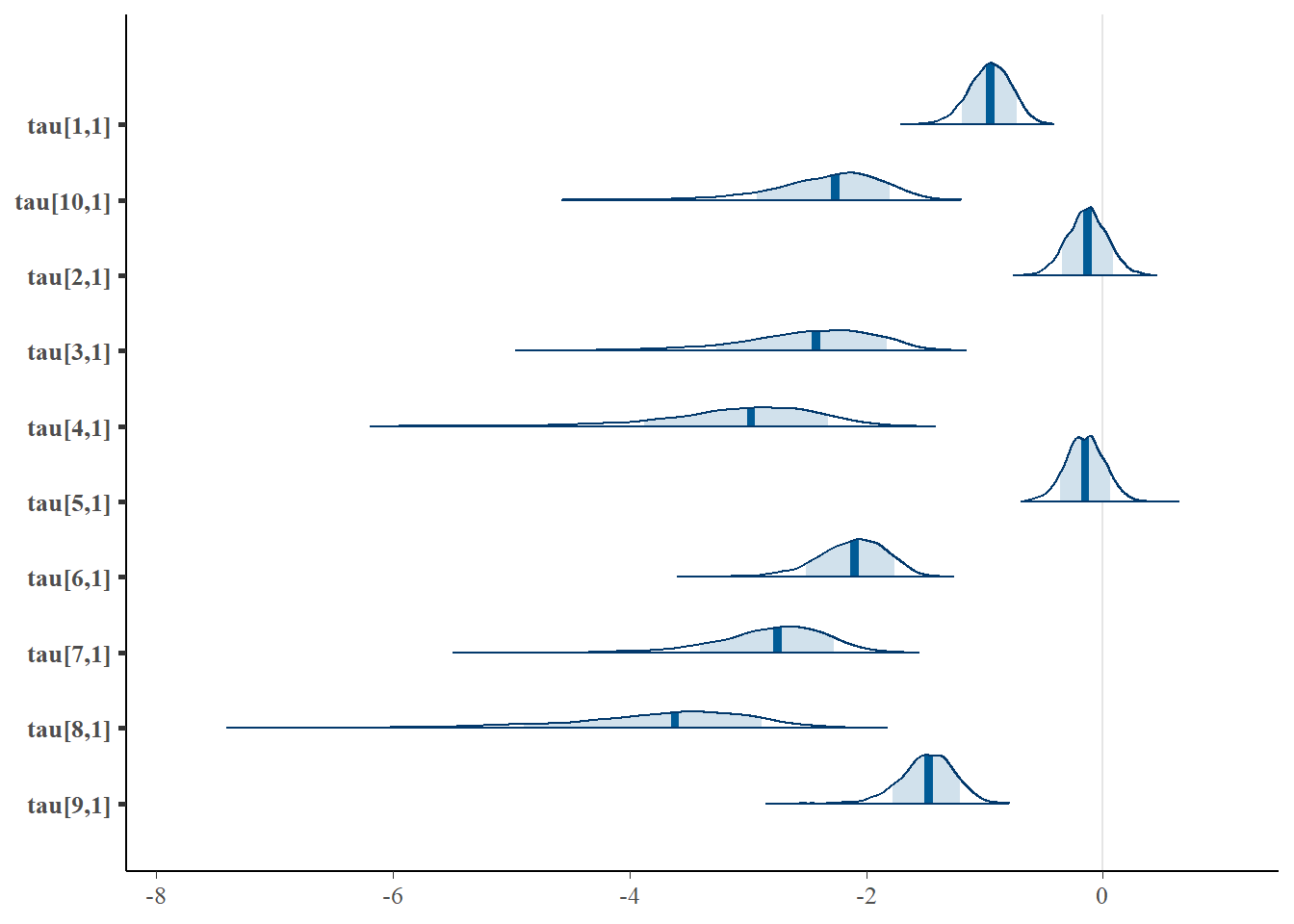
Saving 7 x 5 in imagebayesplot::mcmc_acf(fit.mcmc, regex_pars = "tau"); ggsave("fig/study4_model1_tau_acf.pdf")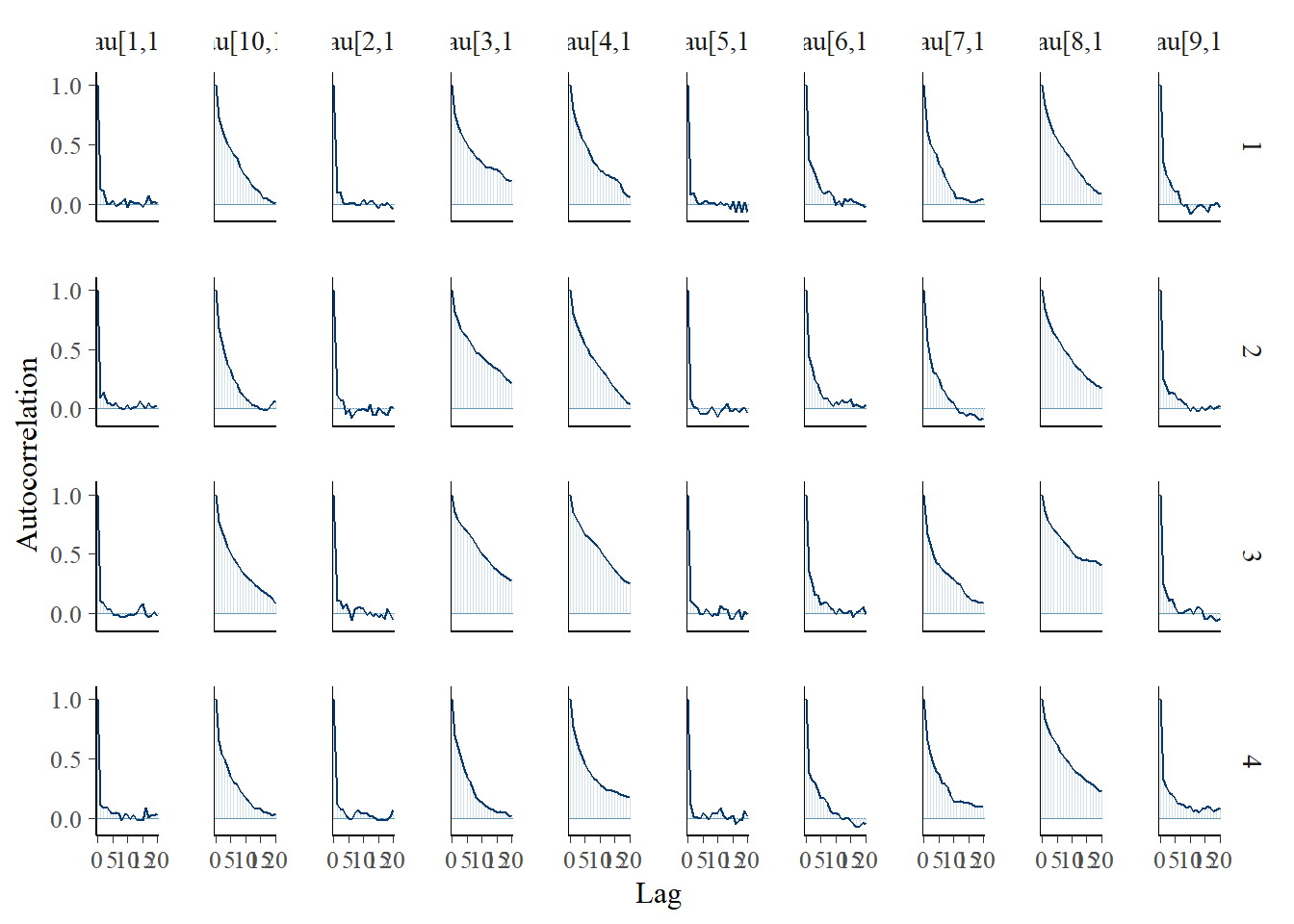
Saving 7 x 5 in imagebayesplot::mcmc_trace(fit.mcmc, regex_pars = "tau"); ggsave("fig/study4_model1_tau_trace.pdf")
Saving 7 x 5 in imageggmcmc::ggs_grb(fit.mcmc.ggs, family = "tau"); ggsave("fig/study4_model1_tau_grb.pdf")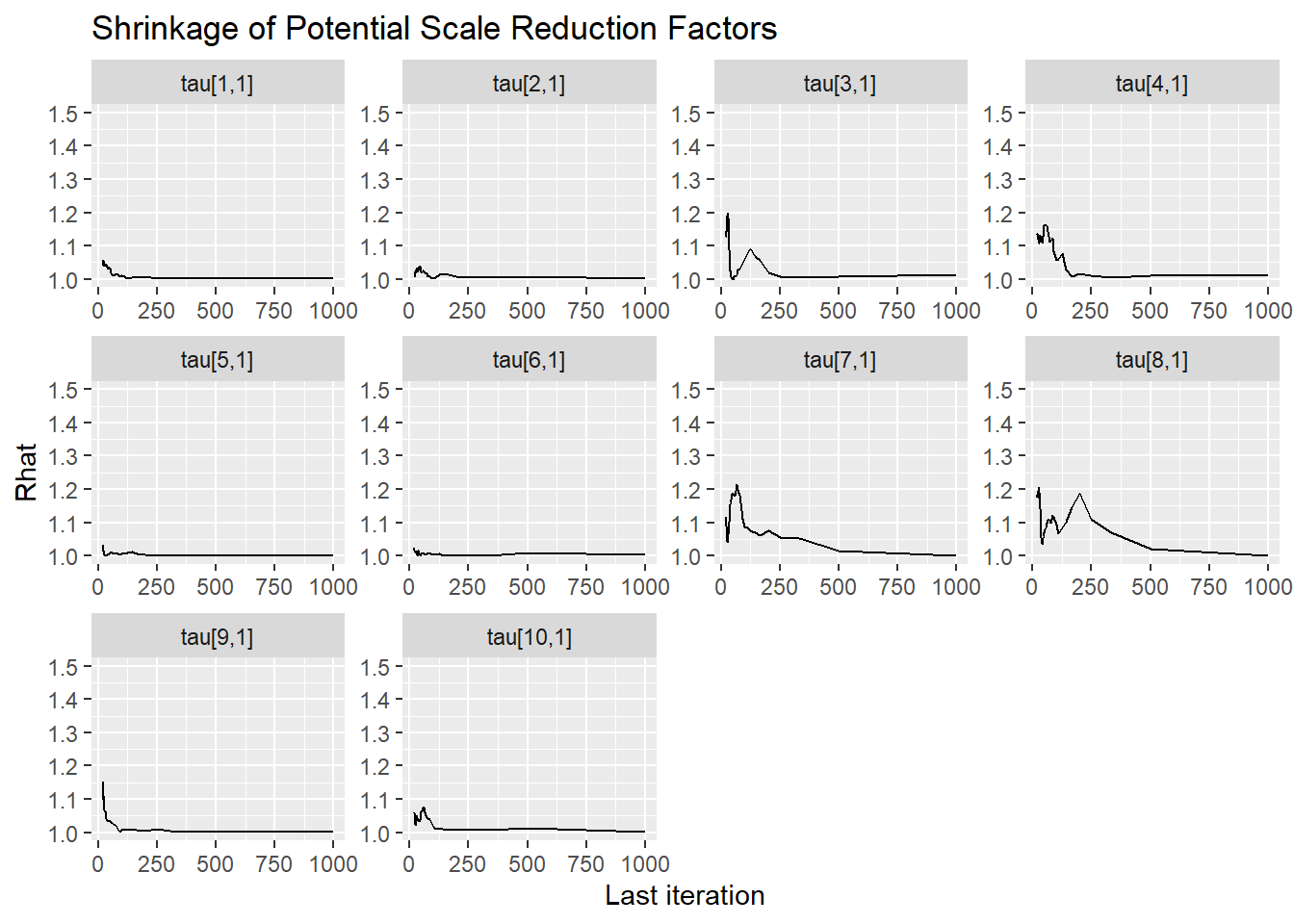
Saving 7 x 5 in imageFactor Loadings (\(\lambda\))
bayesplot::mcmc_areas(fit.mcmc, regex_pars = "lambda", prob = 0.8)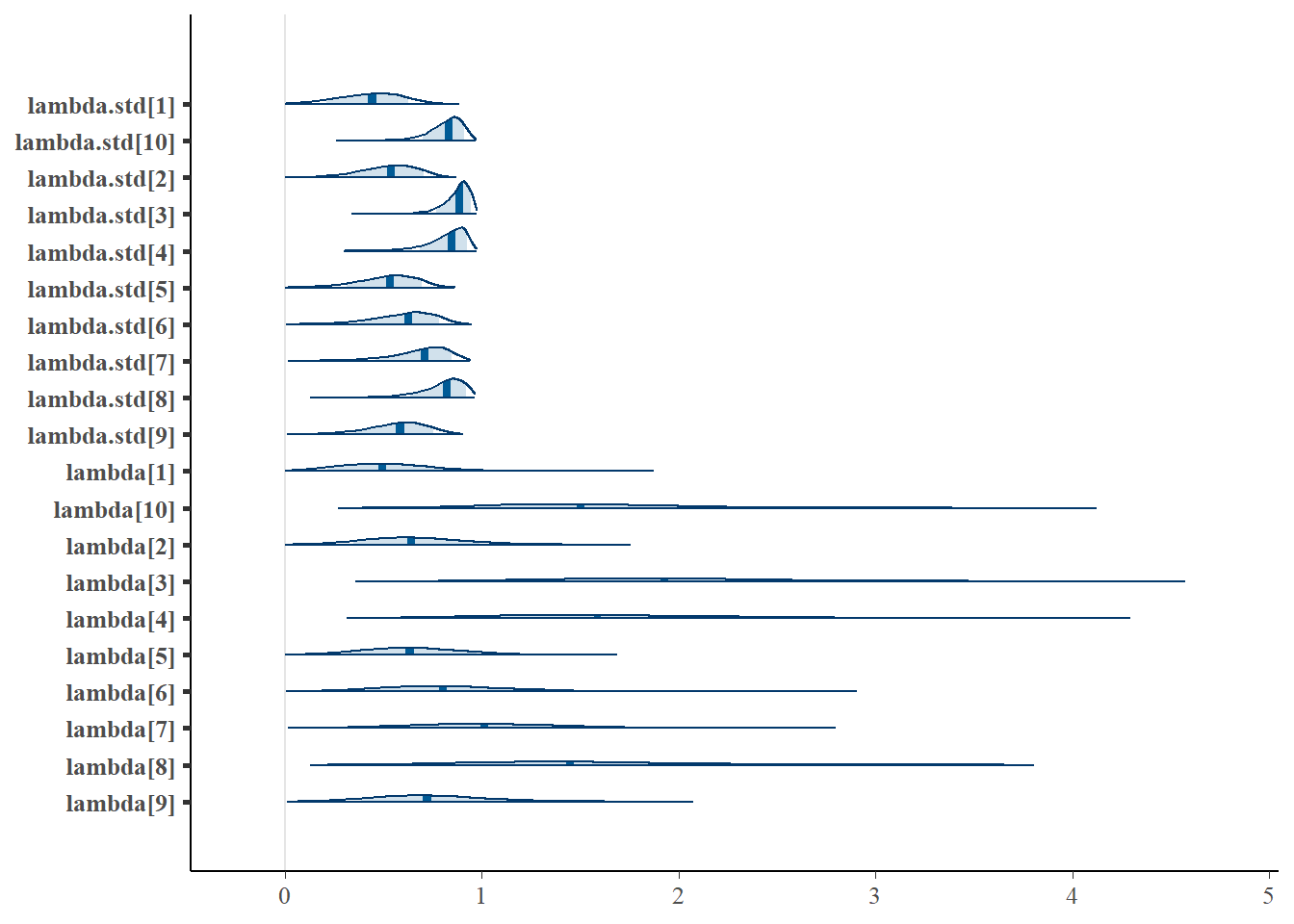
bayesplot::mcmc_acf(fit.mcmc, regex_pars = "lambda")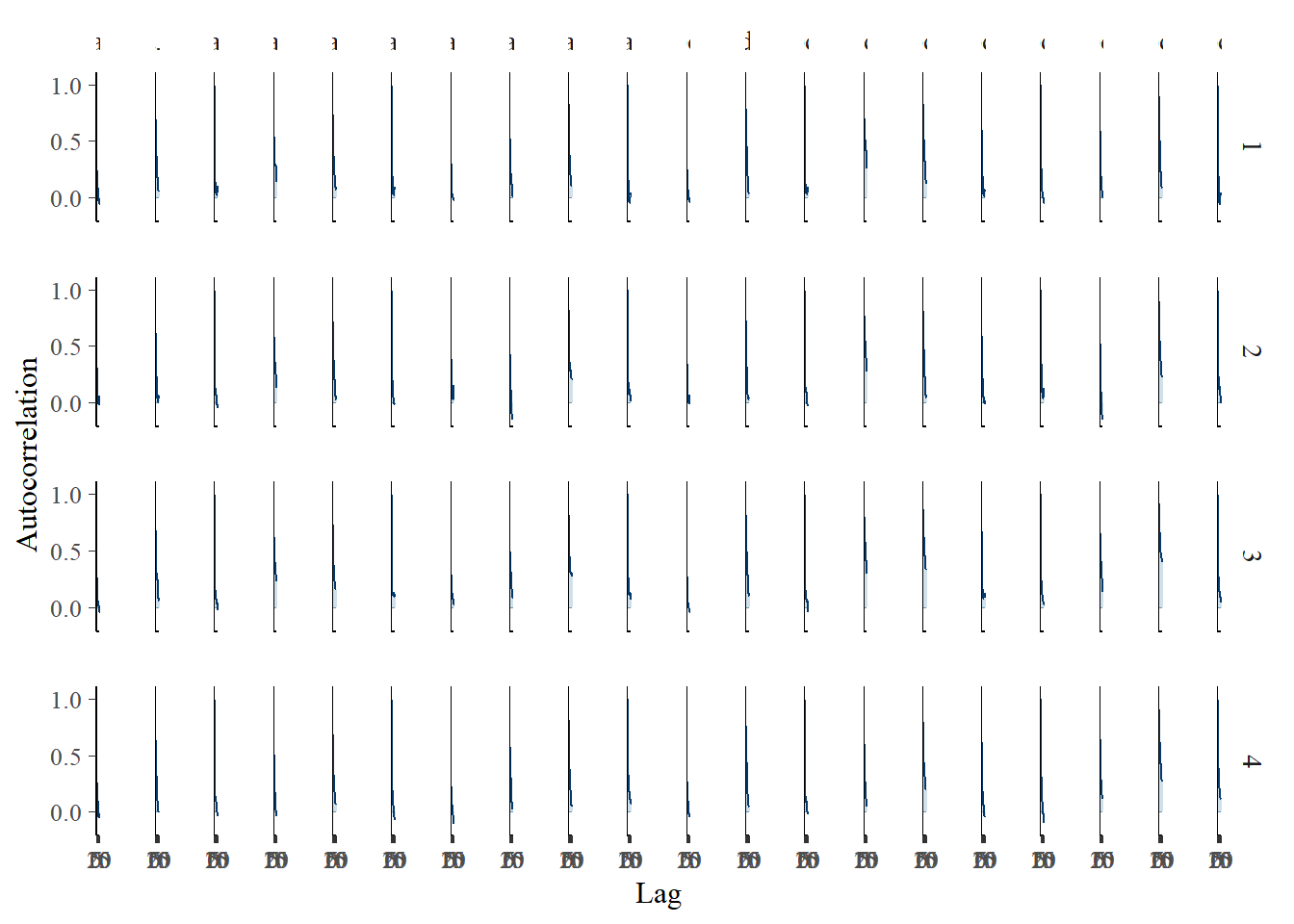
bayesplot::mcmc_trace(fit.mcmc, regex_pars = "lambda")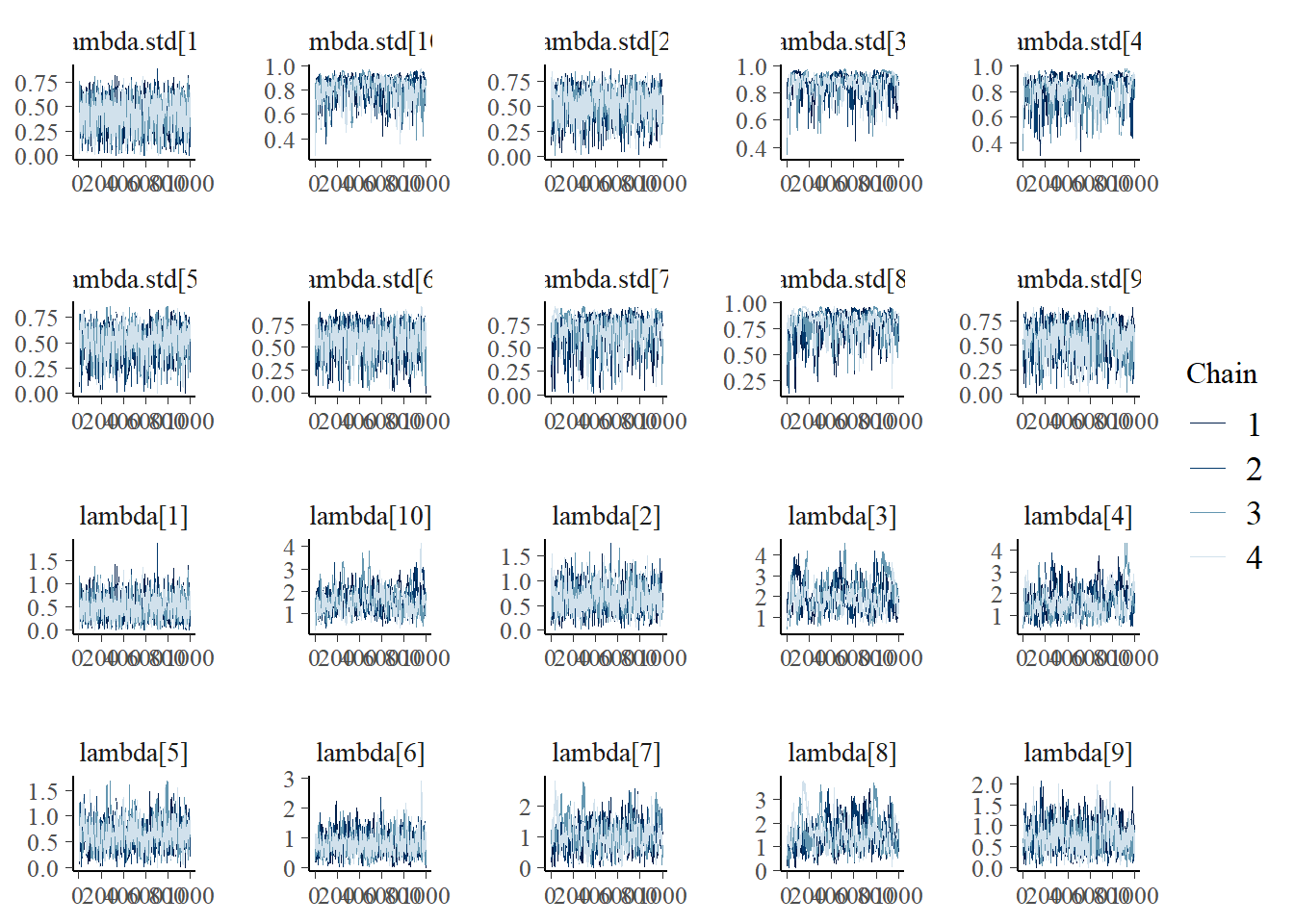
ggmcmc::ggs_grb(fit.mcmc.ggs, family = "lambda")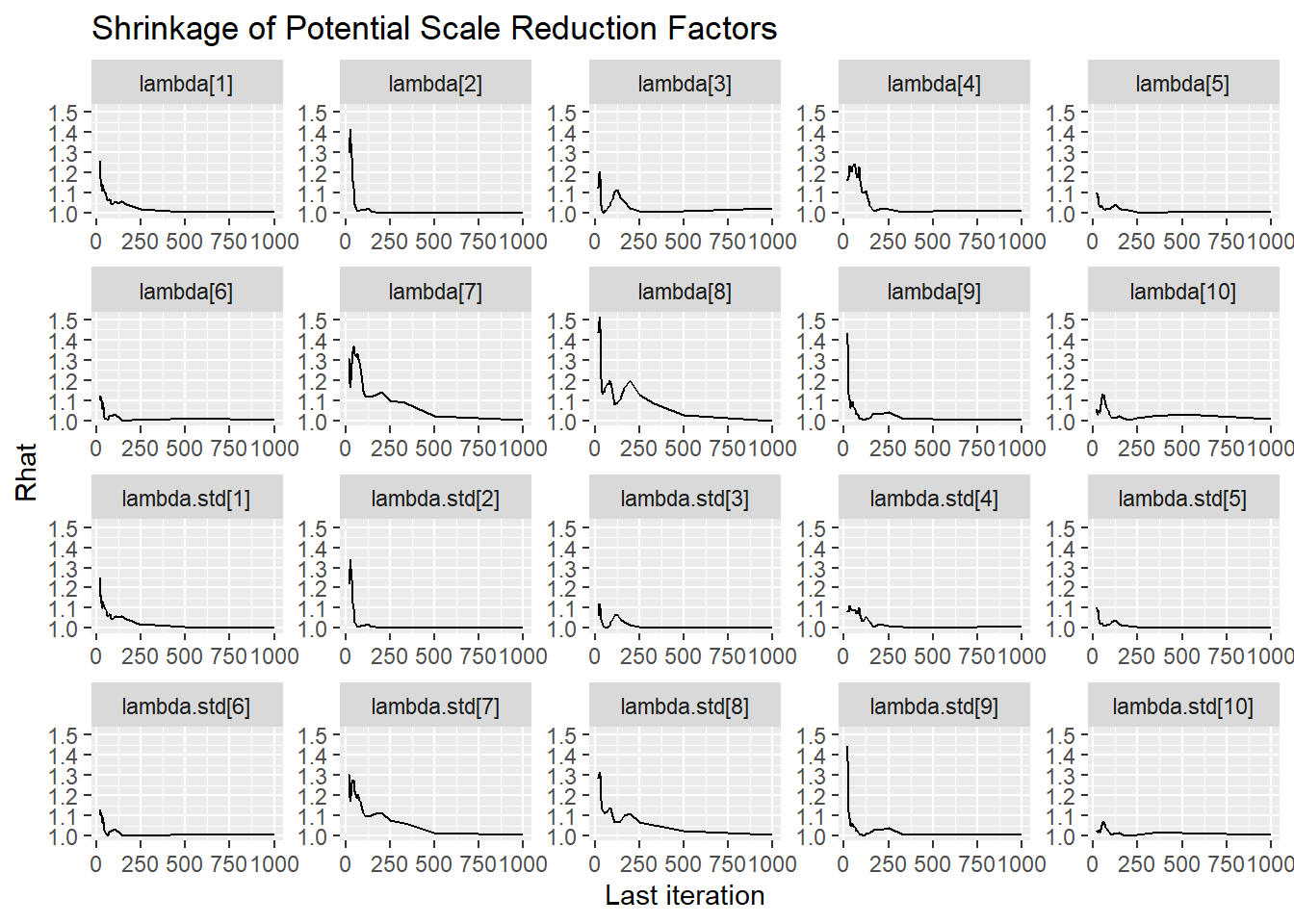
bayesplot::mcmc_areas(fit.mcmc, regex_pars = "lambda.std", prob = 0.8); ggsave("fig/study4_model1_lambda_dens.pdf")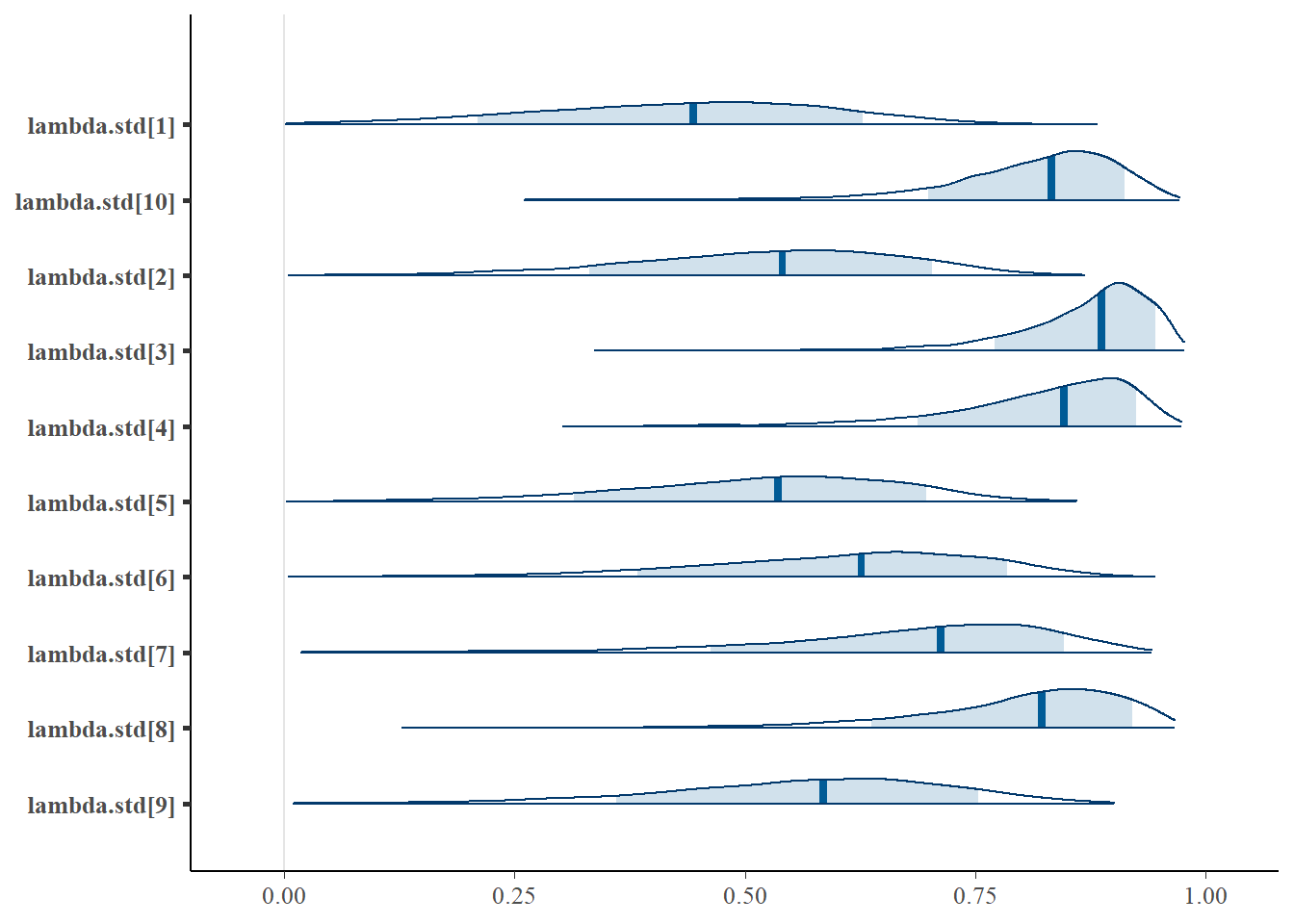
Saving 7 x 5 in imagebayesplot::mcmc_acf(fit.mcmc, regex_pars = "lambda.std"); ggsave("fig/study4_model1_lambda_acf.pdf")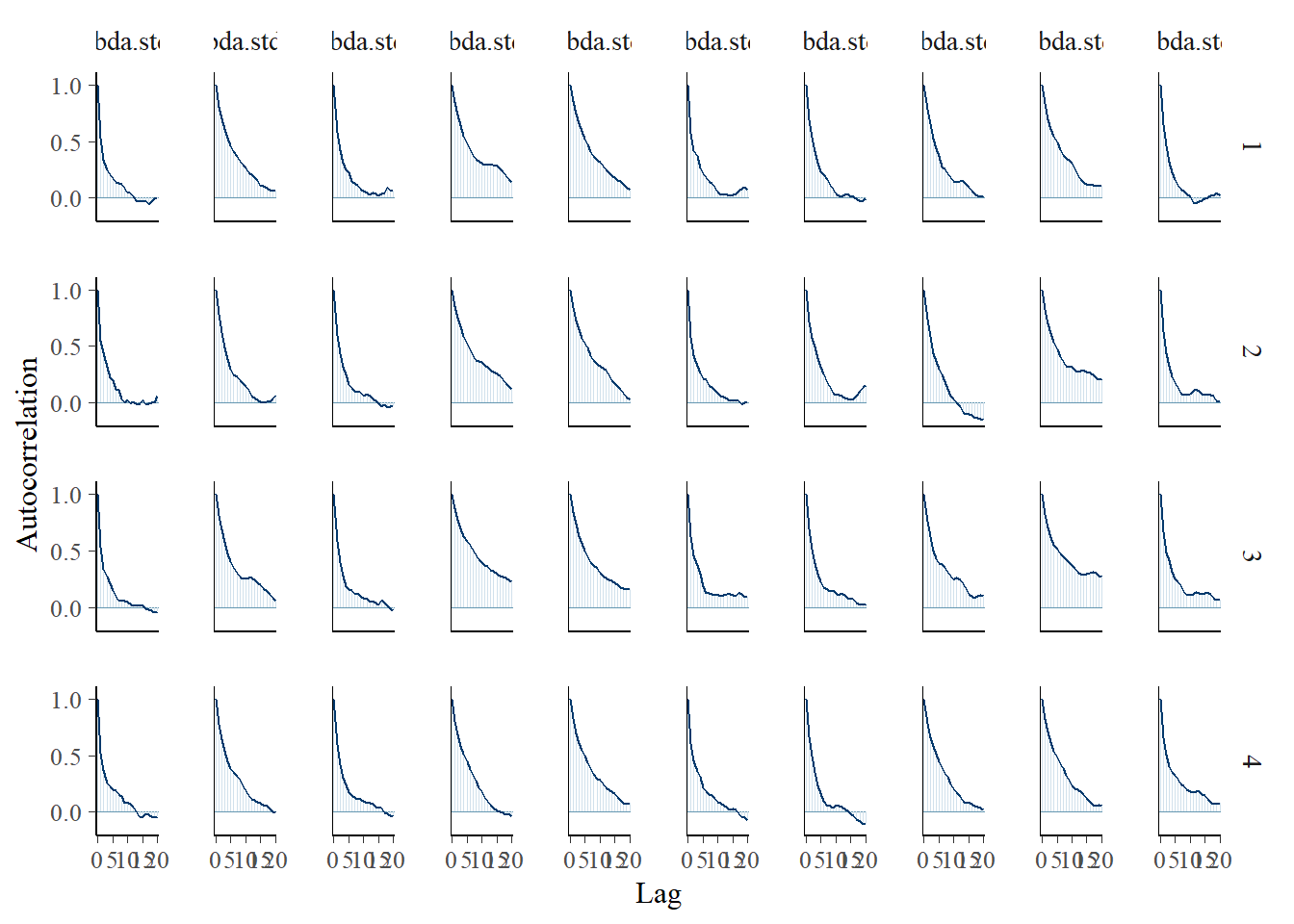
Saving 7 x 5 in imagebayesplot::mcmc_trace(fit.mcmc, regex_pars = "lambda.std"); ggsave("fig/study4_model1_lambda_trace.pdf")
Saving 7 x 5 in imageggmcmc::ggs_grb(fit.mcmc.ggs, family = "lambda.std"); ggsave("fig/study4_model1_lambda_grb.pdf")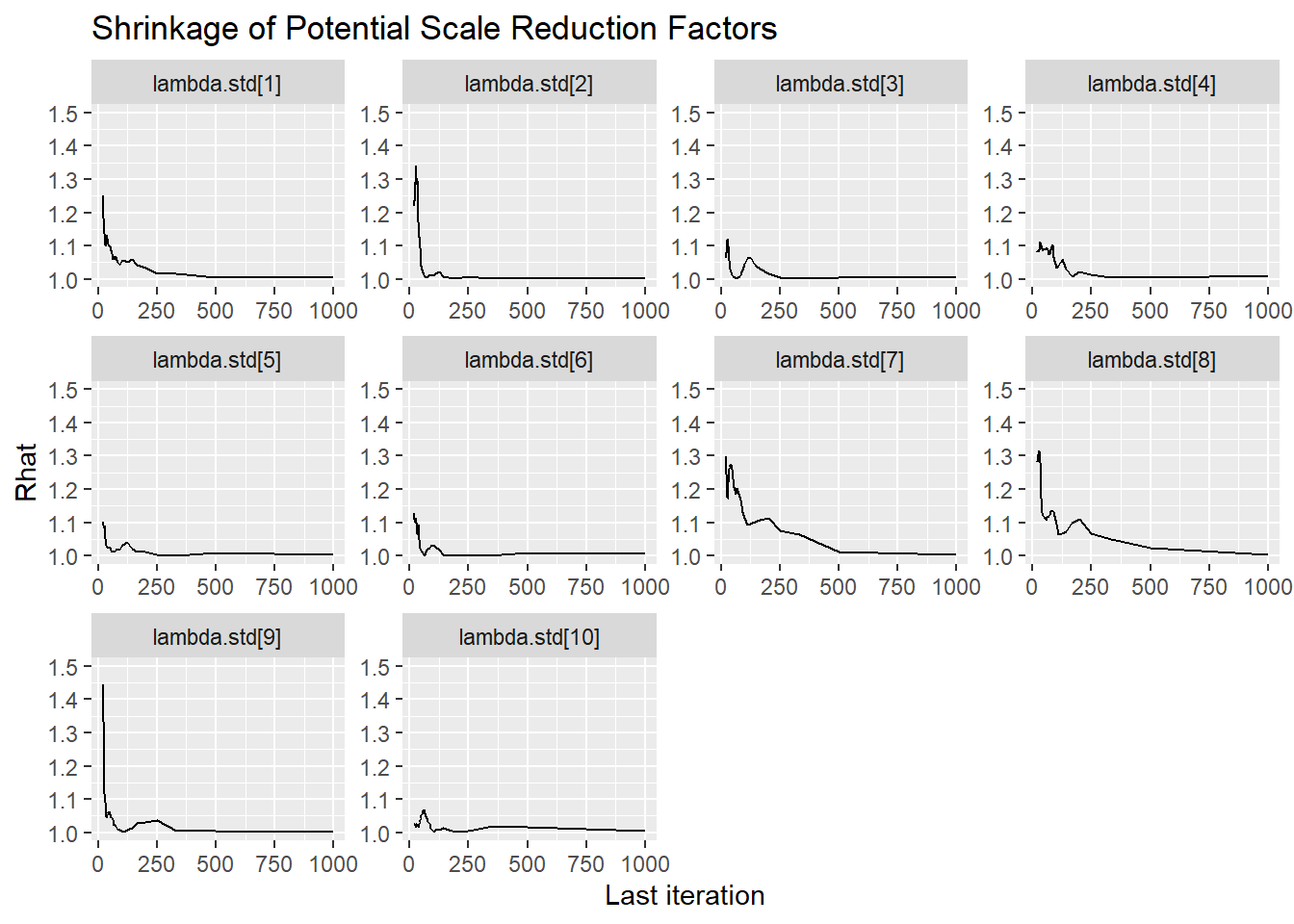
Saving 7 x 5 in imageLatent Response Total Variance (\(\theta\))
bayesplot::mcmc_areas(fit.mcmc, regex_pars = "theta", prob = 0.8); ggsave("fig/study4_model1_theta_dens.pdf")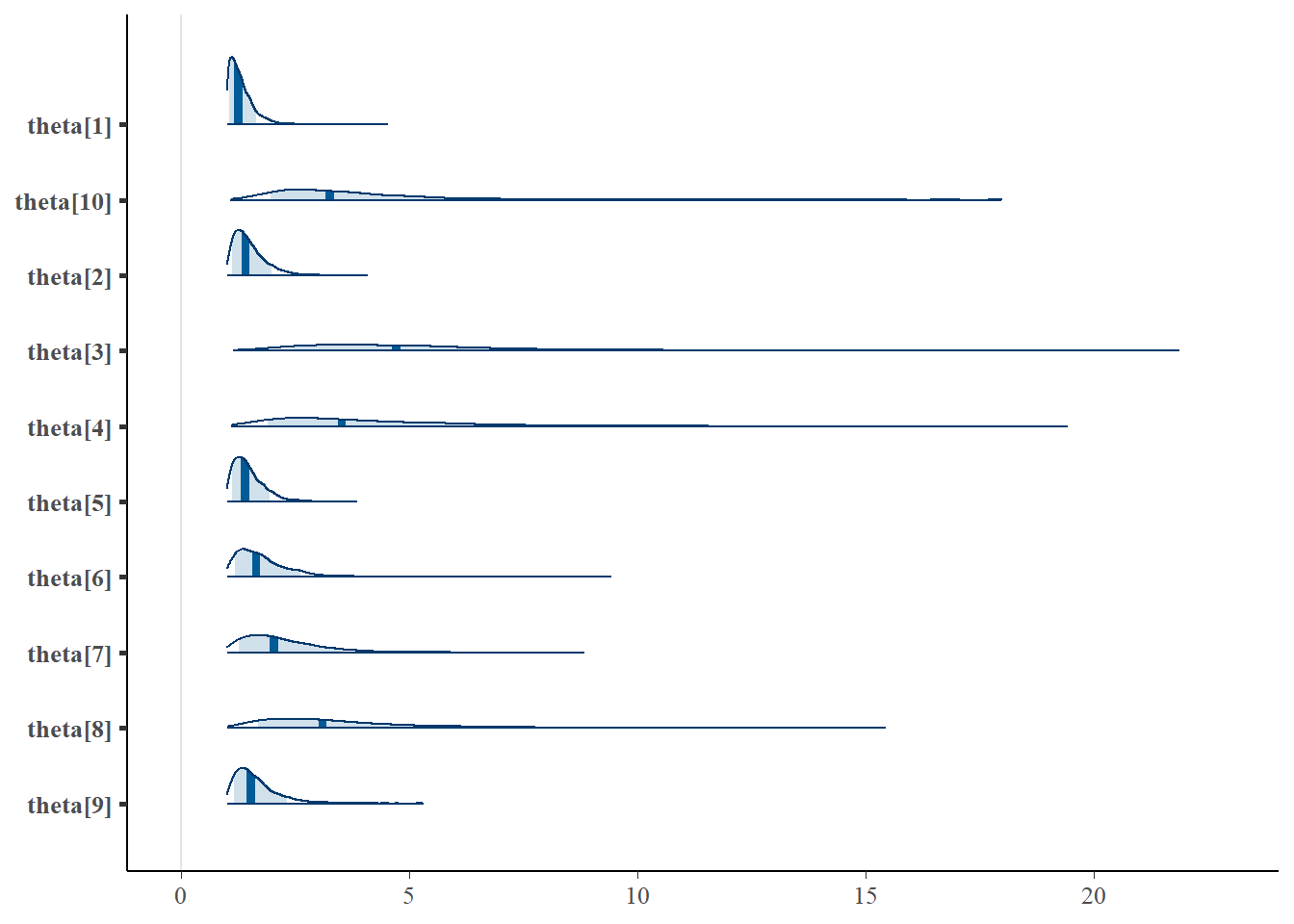
Saving 7 x 5 in imagebayesplot::mcmc_acf(fit.mcmc, regex_pars = "theta"); ggsave("fig/study4_model1_theta_acf.pdf")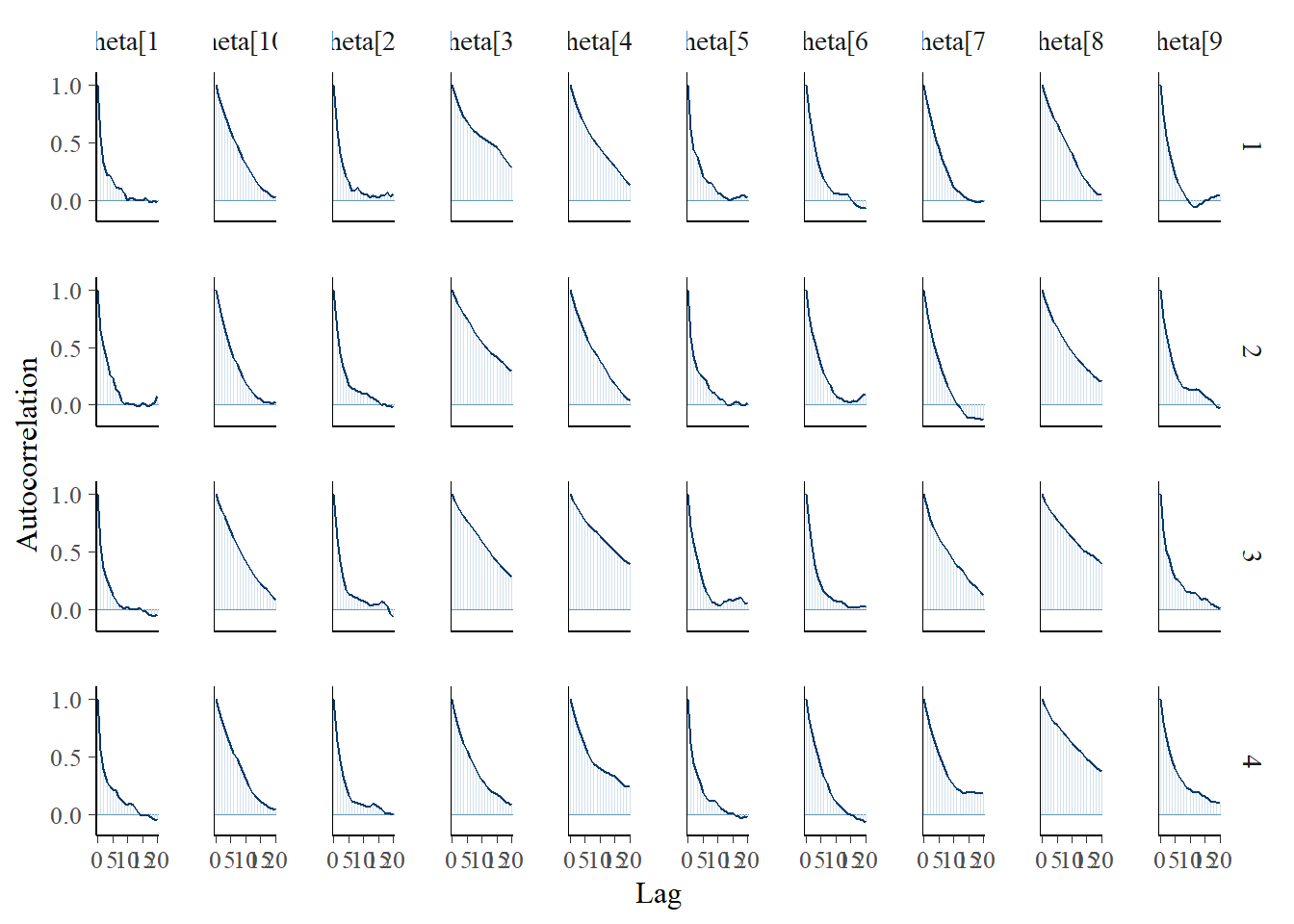
Saving 7 x 5 in imagebayesplot::mcmc_trace(fit.mcmc, regex_pars = "theta"); ggsave("fig/study4_model1_theta_trace.pdf")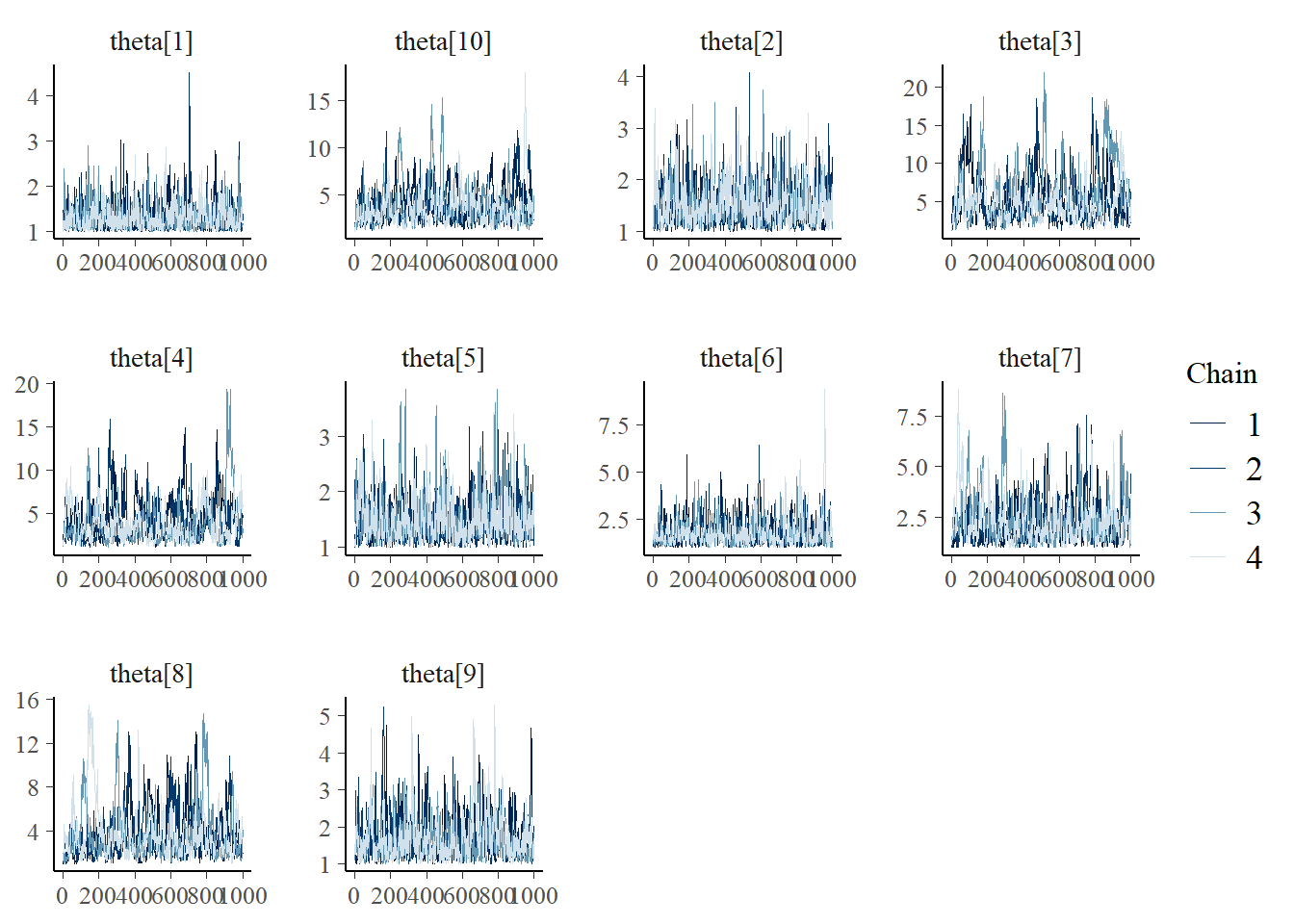
Saving 7 x 5 in imageggmcmc::ggs_grb(fit.mcmc.ggs, family = "theta"); ggsave("fig/study4_model1_theta_grb.pdf")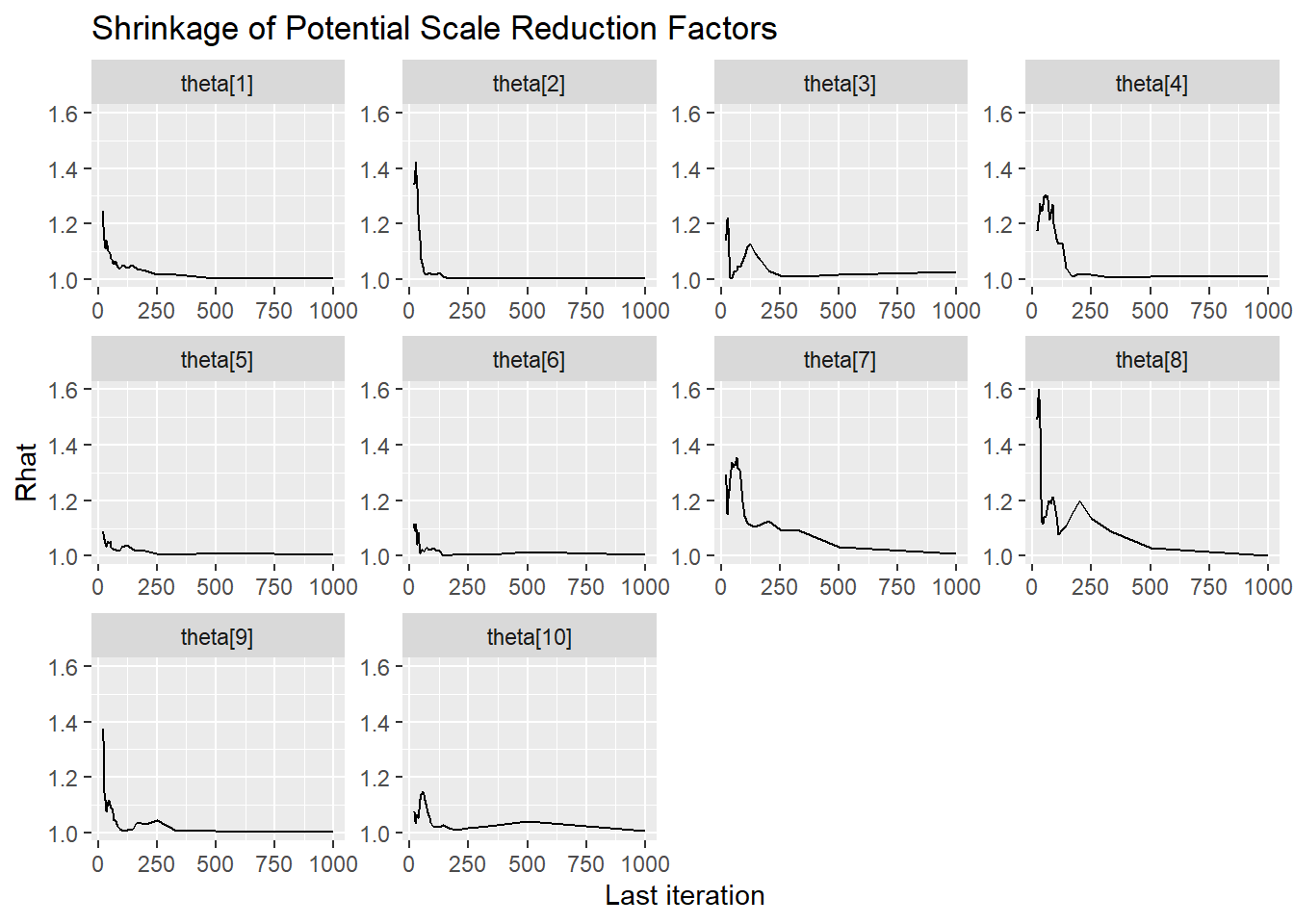
Saving 7 x 5 in imageFactor Reliability Omega (\(\omega\))
bayesplot::mcmc_areas(fit.mcmc, regex_pars = "reli.omega", prob = 0.8); ggsave("fig/study4_model1_omega_dens.pdf")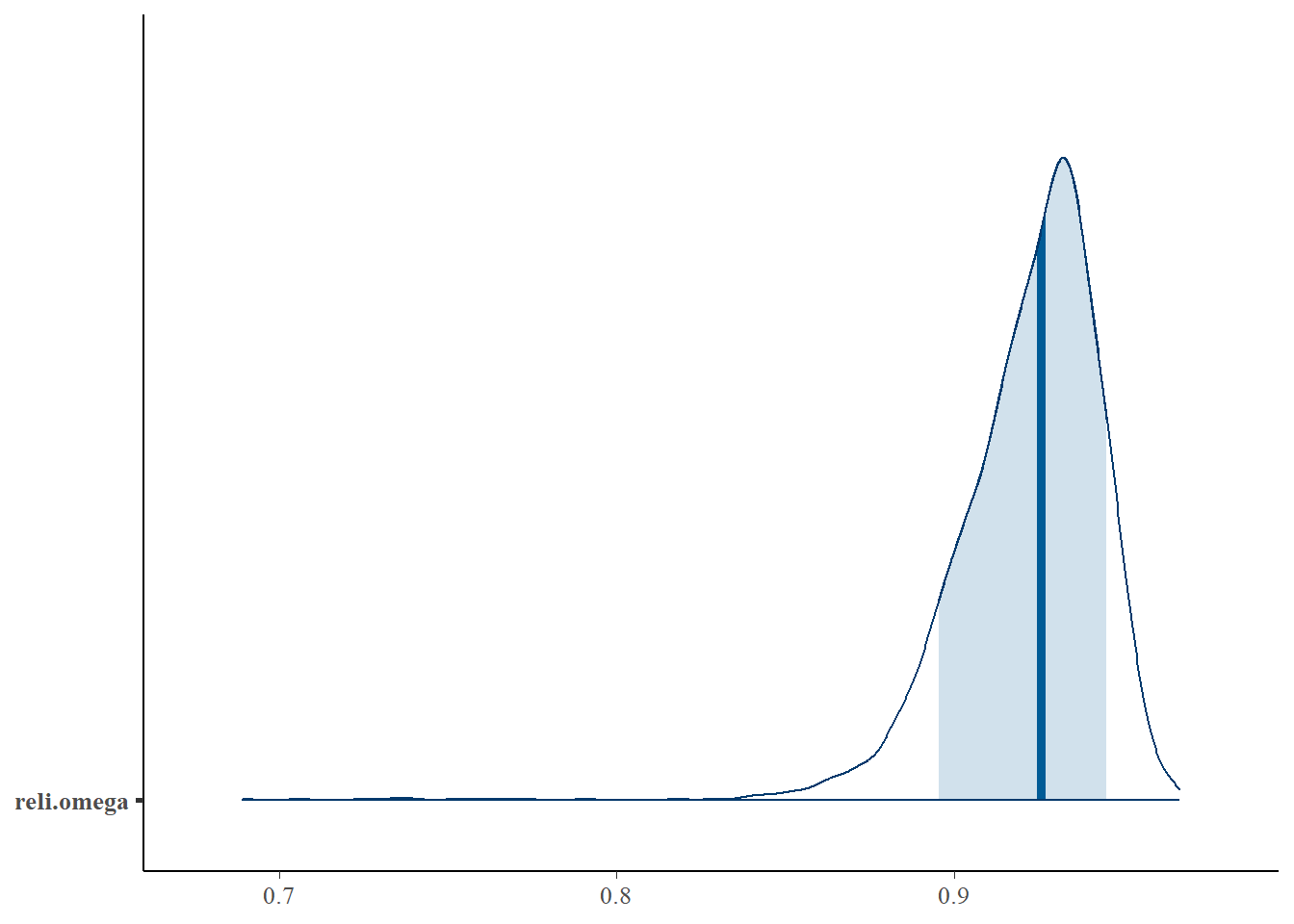
Saving 7 x 5 in imagebayesplot::mcmc_acf(fit.mcmc, regex_pars = "reli.omega"); ggsave("fig/study4_model1_omega_acf.pdf")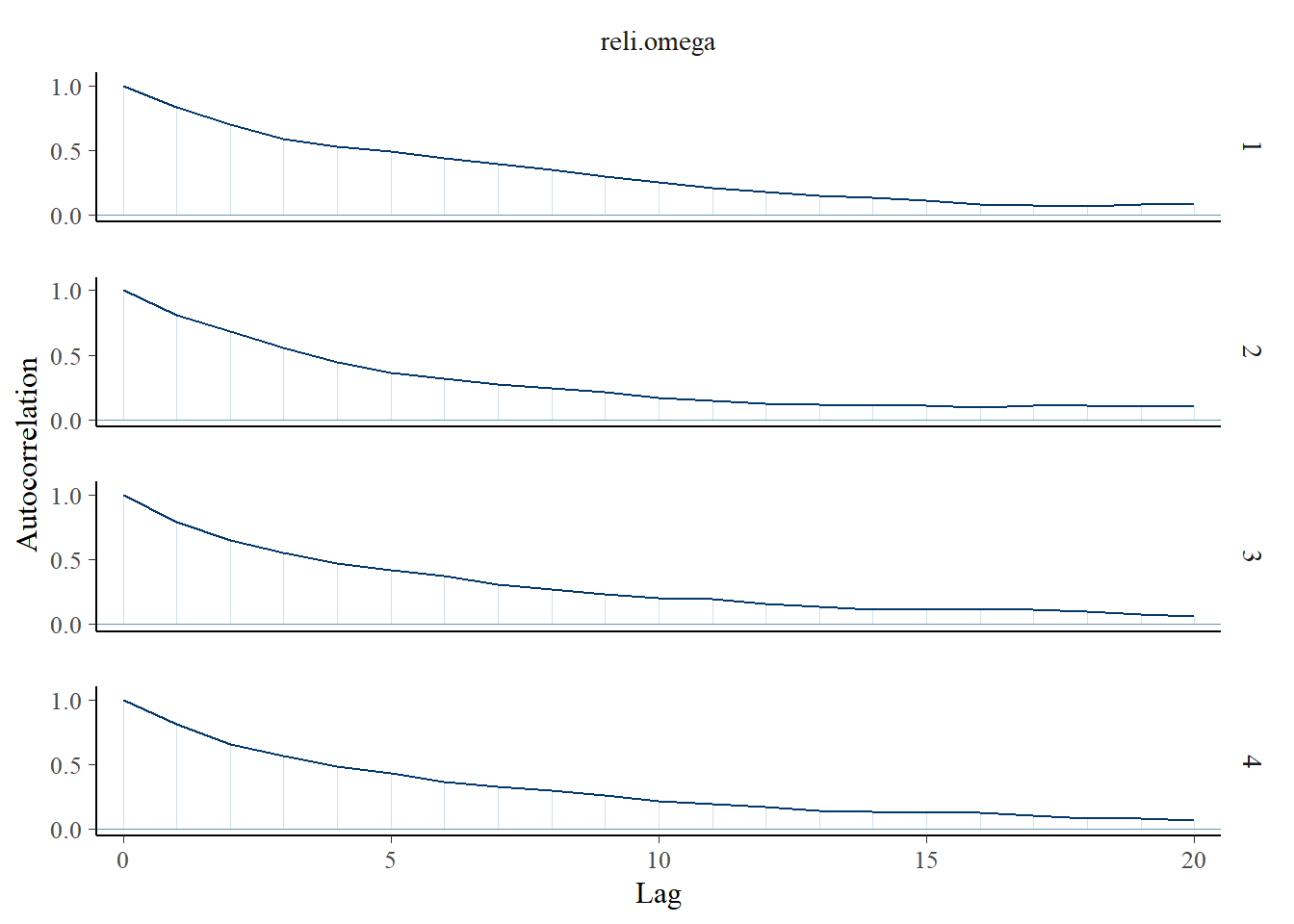
Saving 7 x 5 in imagebayesplot::mcmc_trace(fit.mcmc, regex_pars = "reli.omega"); ggsave("fig/study4_model1_omega_trace.pdf")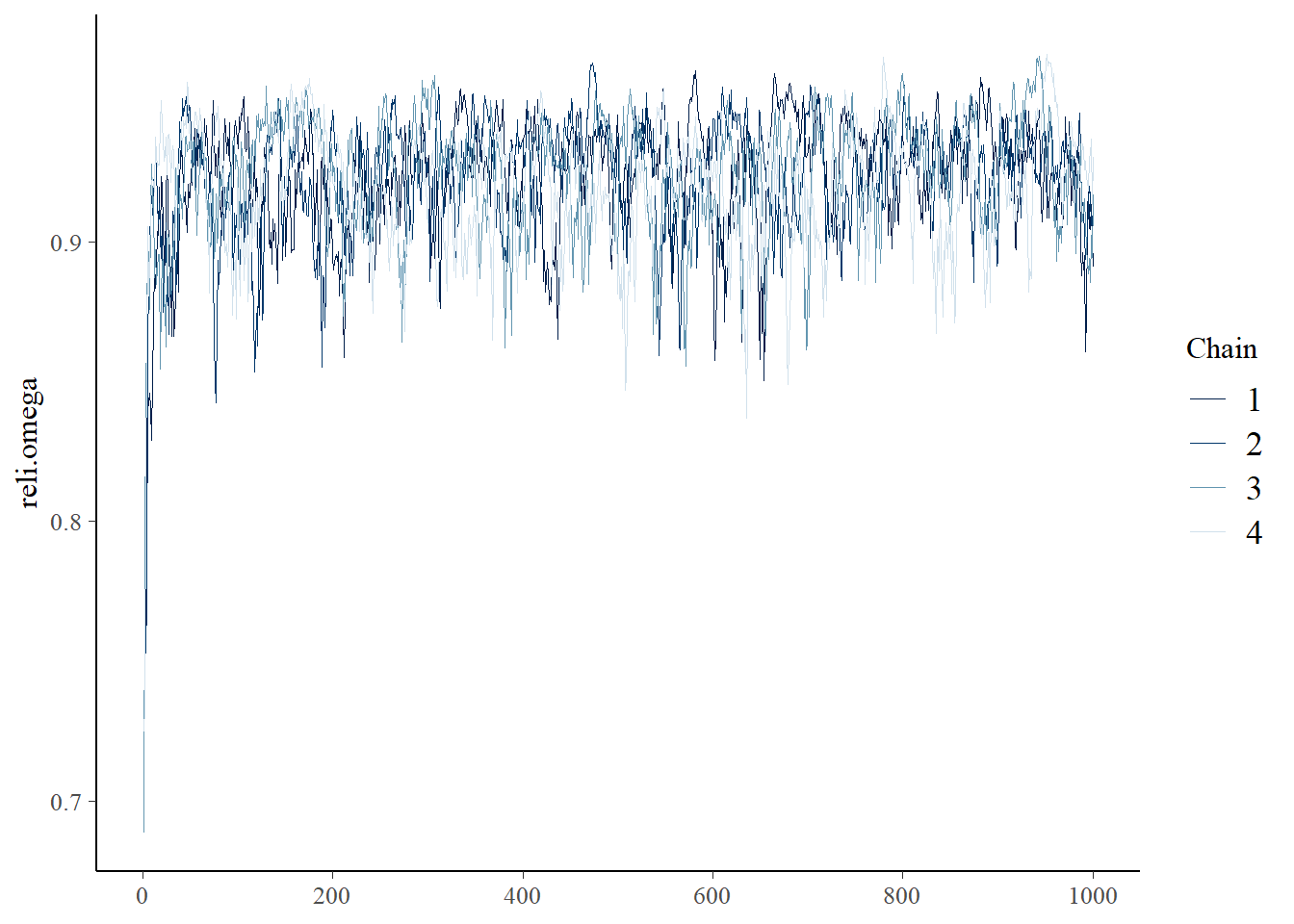
Saving 7 x 5 in imageggmcmc::ggs_grb(fit.mcmc.ggs, family = "reli.omega"); ggsave("fig/study4_model1_omega_grb.pdf")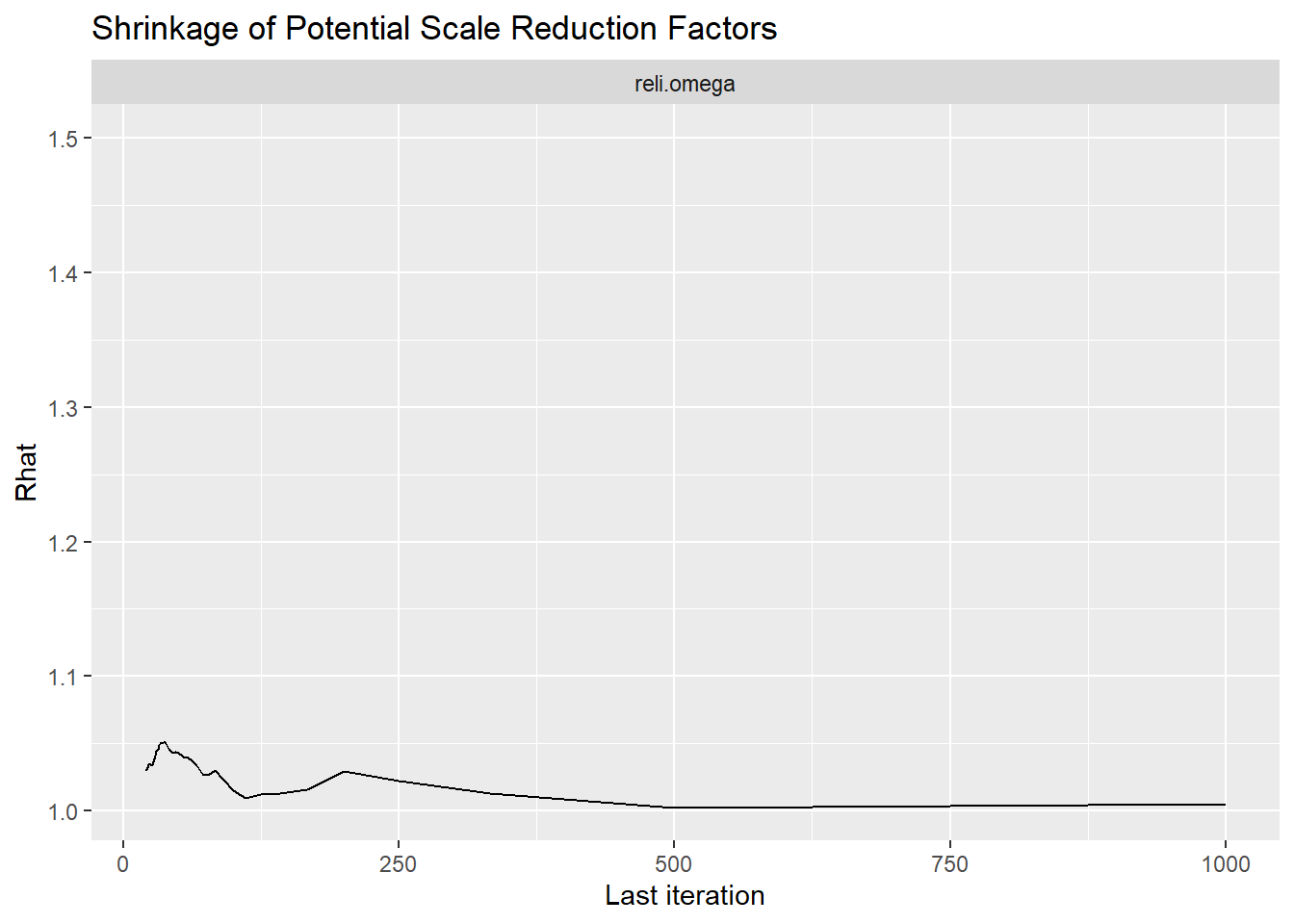
Saving 7 x 5 in image# extract omega posterior for results comparison
extracted_omega <- data.frame(model_1 = fit.mcmc$reli.omega)
write.csv(x=extracted_omega, file=paste0(getwd(),"/data/study_4/extracted_omega_m1.csv"))Posterior Predictive Distributions
# Posterior Predictive Check
Niter <- 200
model.fit$model$recompile()Compiling model graph
Resolving undeclared variables
Allocating nodes
Graph information:
Observed stochastic nodes: 1420
Unobserved stochastic nodes: 1582
Total graph size: 8742
Initializing modelfit.extra <- rjags::jags.samples(model.fit$model, variable.names = "pi", n.iter = Niter)
N <- model.fit$model$data()[["N"]]
nit <- 10
nchain=4
C <- 2
n <- i <- iter <- ppc.row.i <- 1
y.prob.ppc <- array(dim=c(Niter*nchain, nit, C))
for(chain in 1:nchain){
for(iter in 1:Niter){
# initialize simulated y for this iteration
y <- matrix(nrow=N, ncol=nit)
# loop over item
for(i in 1:nit){
# simulated data for item i for each person
for(n in 1:N){
y[n,i] <- sample(1:C, 1, prob = fit.extra$pi[n, i, 1:C, iter, chain])
}
# computer proportion of each response category
for(c in 1:C){
y.prob.ppc[ppc.row.i,i,c] <- sum(y[,i]==c)/N
}
}
# update row of output
ppc.row.i = ppc.row.i + 1
}
}
yppcmat <- matrix(c(y.prob.ppc), ncol=1)
z <- expand.grid(1:(Niter*nchain), 1:nit, 1:C)
yppcmat <- data.frame( iter = z[,1], nit=z[,2], C=z[,3], yppc = yppcmat)
ymat <- model.fit$model$data()[["y"]]
y.prob <- matrix(ncol=C, nrow=nit)
for(i in 1:nit){
for(c in 1:C){
y.prob[i,c] <- sum(ymat[,i]==c-1)/N
}
}
yobsmat <- matrix(c(y.prob), ncol=1)
z <- expand.grid(1:nit, 1:C)
yobsmat <- data.frame(nit=z[,1], C=z[,2], yobs = yobsmat)
plot.ppc <- full_join(yppcmat, yobsmat)Joining, by = c("nit", "C")p <- plot.ppc %>%
mutate(C = as.factor(C),
item = nit) %>%
ggplot()+
geom_boxplot(aes(x=C,y=y.prob.ppc), outlier.colour = NA)+
geom_point(aes(x=C,y=yobs), color="red")+
lims(y=c(0, 1))+
labs(y="Posterior Predictive Category Proportion", x="Item Category")+
facet_wrap(.~nit, nrow=1)+
theme_bw()+
theme(
panel.grid = element_blank(),
strip.background = element_rect(fill="white")
)
p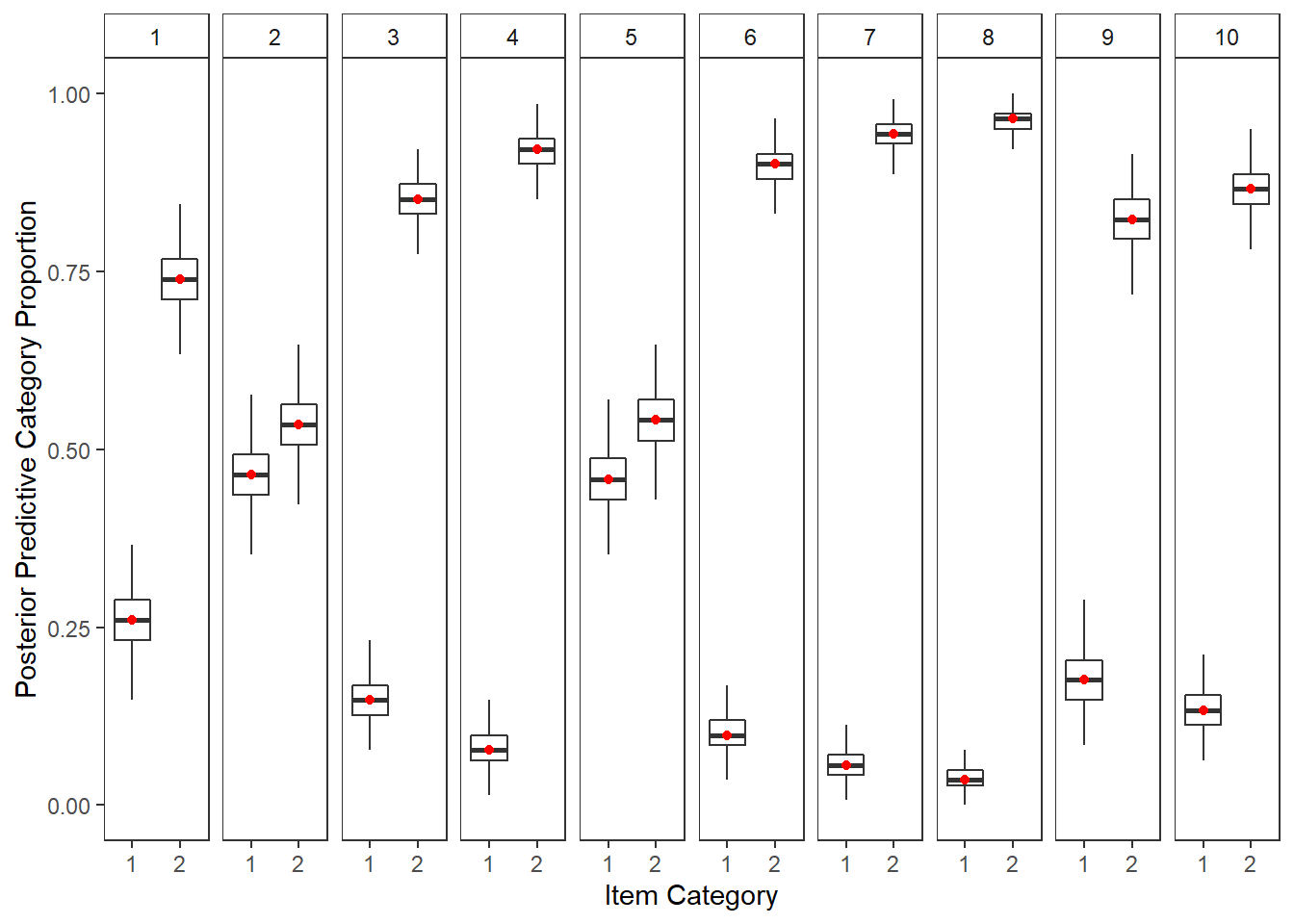
ggsave(filename = "fig/study4_model1_ppc_y.pdf",plot=p,width = 6, height=3,units="in")
ggsave(filename = "fig/study4_model1_ppc_y.png",plot=p,width = 6, height=3,units="in")
ggsave(filename = "fig/study4_model1_ppc_y.eps",plot=p,width = 6, height=3,units="in")Manuscript Table and Figures
Table
# print to xtable
print(
xtable(
model.fit$BUGSoutput$summary,
caption = c("study4 Model 1 posterior distribution summary")
,align = "lrrrrrrrrr"
),
include.rownames=T,
booktabs=T
)% latex table generated in R 4.0.5 by xtable 1.8-4 package
% Thu Jan 20 13:28:36 2022
\begin{table}[ht]
\centering
\begin{tabular}{lrrrrrrrrr}
\toprule
& mean & sd & 2.5\% & 25\% & 50\% & 75\% & 97.5\% & Rhat & n.eff \\
\midrule
deviance & 704.72 & 30.59 & 647.94 & 684.71 & 703.64 & 723.98 & 763.98 & 1.00 & 1600.00 \\
lambda[1] & 0.51 & 0.23 & 0.10 & 0.34 & 0.50 & 0.66 & 1.00 & 1.01 & 430.00 \\
lambda[2] & 0.66 & 0.25 & 0.21 & 0.48 & 0.64 & 0.81 & 1.18 & 1.00 & 650.00 \\
lambda[3] & 2.00 & 0.66 & 0.92 & 1.52 & 1.93 & 2.37 & 3.52 & 1.03 & 130.00 \\
lambda[4] & 1.66 & 0.60 & 0.69 & 1.23 & 1.59 & 2.03 & 3.01 & 1.02 & 160.00 \\
lambda[5] & 0.65 & 0.25 & 0.18 & 0.47 & 0.63 & 0.81 & 1.18 & 1.01 & 480.00 \\
lambda[6] & 0.83 & 0.35 & 0.23 & 0.59 & 0.80 & 1.03 & 1.60 & 1.01 & 350.00 \\
lambda[7] & 1.05 & 0.43 & 0.27 & 0.75 & 1.01 & 1.31 & 2.03 & 1.01 & 450.00 \\
lambda[8] & 1.53 & 0.61 & 0.56 & 1.10 & 1.45 & 1.86 & 3.02 & 1.00 & 760.00 \\
lambda[9] & 0.75 & 0.31 & 0.23 & 0.54 & 0.72 & 0.92 & 1.45 & 1.00 & 580.00 \\
lambda[10] & 1.57 & 0.51 & 0.74 & 1.20 & 1.50 & 1.85 & 2.78 & 1.01 & 310.00 \\
lambda.std[1] & 0.43 & 0.16 & 0.10 & 0.32 & 0.44 & 0.55 & 0.71 & 1.01 & 430.00 \\
lambda.std[2] & 0.53 & 0.15 & 0.21 & 0.43 & 0.54 & 0.63 & 0.76 & 1.00 & 700.00 \\
lambda.std[3] & 0.87 & 0.08 & 0.68 & 0.84 & 0.89 & 0.92 & 0.96 & 1.02 & 330.00 \\
lambda.std[4] & 0.82 & 0.10 & 0.57 & 0.77 & 0.85 & 0.90 & 0.95 & 1.01 & 210.00 \\
lambda.std[5] & 0.52 & 0.15 & 0.18 & 0.43 & 0.54 & 0.63 & 0.76 & 1.01 & 590.00 \\
lambda.std[6] & 0.60 & 0.16 & 0.22 & 0.51 & 0.63 & 0.72 & 0.85 & 1.01 & 400.00 \\
lambda.std[7] & 0.68 & 0.16 & 0.26 & 0.60 & 0.71 & 0.79 & 0.90 & 1.01 & 630.00 \\
lambda.std[8] & 0.80 & 0.12 & 0.49 & 0.74 & 0.82 & 0.88 & 0.95 & 1.02 & 540.00 \\
lambda.std[9] & 0.57 & 0.15 & 0.23 & 0.47 & 0.59 & 0.68 & 0.82 & 1.00 & 710.00 \\
lambda.std[10] & 0.82 & 0.09 & 0.60 & 0.77 & 0.83 & 0.88 & 0.94 & 1.01 & 350.00 \\
reli.omega & 0.92 & 0.02 & 0.88 & 0.91 & 0.93 & 0.94 & 0.95 & 1.01 & 370.00 \\
tau[1,1] & -0.96 & 0.18 & -1.33 & -1.07 & -0.95 & -0.83 & -0.62 & 1.00 & 1400.00 \\
tau[2,1] & -0.13 & 0.17 & -0.46 & -0.24 & -0.13 & -0.02 & 0.20 & 1.00 & 910.00 \\
tau[3,1] & -2.50 & 0.58 & -3.90 & -2.82 & -2.43 & -2.08 & -1.61 & 1.03 & 140.00 \\
tau[4,1] & -3.06 & 0.64 & -4.57 & -3.40 & -2.98 & -2.61 & -2.05 & 1.02 & 200.00 \\
tau[5,1] & -0.15 & 0.17 & -0.48 & -0.26 & -0.15 & -0.04 & 0.17 & 1.00 & 4000.00 \\
tau[6,1] & -2.13 & 0.30 & -2.80 & -2.31 & -2.10 & -1.91 & -1.62 & 1.01 & 510.00 \\
tau[7,1] & -2.80 & 0.46 & -3.85 & -3.06 & -2.75 & -2.48 & -2.05 & 1.00 & 1600.00 \\
tau[8,1] & -3.77 & 0.81 & -5.77 & -4.19 & -3.62 & -3.19 & -2.55 & 1.00 & 2200.00 \\
tau[9,1] & -1.48 & 0.23 & -1.97 & -1.62 & -1.47 & -1.33 & -1.08 & 1.01 & 470.00 \\
tau[10,1] & -2.32 & 0.46 & -3.40 & -2.58 & -2.26 & -2.00 & -1.60 & 1.01 & 610.00 \\
theta[1] & 1.31 & 0.28 & 1.01 & 1.12 & 1.25 & 1.43 & 2.01 & 1.00 & 620.00 \\
theta[2] & 1.49 & 0.37 & 1.05 & 1.23 & 1.41 & 1.66 & 2.40 & 1.00 & 650.00 \\
theta[3] & 5.42 & 2.96 & 1.85 & 3.32 & 4.72 & 6.63 & 13.36 & 1.03 & 100.00 \\
theta[4] & 4.10 & 2.27 & 1.48 & 2.50 & 3.52 & 5.13 & 10.06 & 1.02 & 160.00 \\
theta[5] & 1.48 & 0.37 & 1.03 & 1.22 & 1.40 & 1.65 & 2.39 & 1.01 & 340.00 \\
theta[6] & 1.81 & 0.68 & 1.05 & 1.34 & 1.65 & 2.07 & 3.55 & 1.01 & 360.00 \\
theta[7] & 2.28 & 1.04 & 1.07 & 1.57 & 2.03 & 2.70 & 5.11 & 1.01 & 340.00 \\
theta[8] & 3.72 & 2.24 & 1.32 & 2.22 & 3.10 & 4.48 & 10.12 & 1.00 & 1200.00 \\
theta[9] & 1.65 & 0.54 & 1.05 & 1.29 & 1.52 & 1.85 & 3.11 & 1.01 & 450.00 \\
theta[10] & 3.72 & 1.87 & 1.55 & 2.45 & 3.26 & 4.41 & 8.72 & 1.01 & 300.00 \\
\bottomrule
\end{tabular}
\caption{study4 Model 1 posterior distribution summary}
\end{table}Figure
sessionInfo()R version 4.0.5 (2021-03-31)
Platform: x86_64-w64-mingw32/x64 (64-bit)
Running under: Windows 10 x64 (build 22000)
Matrix products: default
locale:
[1] LC_COLLATE=English_United States.1252
[2] LC_CTYPE=English_United States.1252
[3] LC_MONETARY=English_United States.1252
[4] LC_NUMERIC=C
[5] LC_TIME=English_United States.1252
attached base packages:
[1] stats graphics grDevices utils datasets methods base
other attached packages:
[1] car_3.0-10 carData_3.0-4 mvtnorm_1.1-1
[4] LaplacesDemon_16.1.4 runjags_2.2.0-2 lme4_1.1-26
[7] Matrix_1.3-2 sirt_3.9-4 R2jags_0.6-1
[10] rjags_4-12 eRm_1.0-2 diffIRT_1.5
[13] statmod_1.4.35 xtable_1.8-4 kableExtra_1.3.4
[16] lavaan_0.6-7 polycor_0.7-10 bayesplot_1.8.0
[19] ggmcmc_1.5.1.1 coda_0.19-4 data.table_1.14.0
[22] patchwork_1.1.1 forcats_0.5.1 stringr_1.4.0
[25] dplyr_1.0.5 purrr_0.3.4 readr_1.4.0
[28] tidyr_1.1.3 tibble_3.1.0 ggplot2_3.3.5
[31] tidyverse_1.3.0 workflowr_1.6.2
loaded via a namespace (and not attached):
[1] minqa_1.2.4 TAM_3.5-19 colorspace_2.0-0 rio_0.5.26
[5] ellipsis_0.3.1 ggridges_0.5.3 rprojroot_2.0.2 fs_1.5.0
[9] rstudioapi_0.13 farver_2.1.0 fansi_0.4.2 lubridate_1.7.10
[13] xml2_1.3.2 codetools_0.2-18 splines_4.0.5 mnormt_2.0.2
[17] knitr_1.31 jsonlite_1.7.2 nloptr_1.2.2.2 broom_0.7.5
[21] dbplyr_2.1.0 compiler_4.0.5 httr_1.4.2 backports_1.2.1
[25] assertthat_0.2.1 cli_2.3.1 later_1.1.0.1 htmltools_0.5.1.1
[29] tools_4.0.5 gtable_0.3.0 glue_1.4.2 reshape2_1.4.4
[33] Rcpp_1.0.7 cellranger_1.1.0 jquerylib_0.1.3 vctrs_0.3.6
[37] svglite_2.0.0 nlme_3.1-152 psych_2.0.12 xfun_0.21
[41] ps_1.6.0 openxlsx_4.2.3 rvest_1.0.0 lifecycle_1.0.0
[45] MASS_7.3-53.1 scales_1.1.1 ragg_1.1.1 hms_1.0.0
[49] promises_1.2.0.1 parallel_4.0.5 RColorBrewer_1.1-2 curl_4.3
[53] yaml_2.2.1 sass_0.3.1 reshape_0.8.8 stringi_1.5.3
[57] highr_0.8 zip_2.1.1 boot_1.3-27 rlang_0.4.10
[61] pkgconfig_2.0.3 systemfonts_1.0.1 evaluate_0.14 lattice_0.20-41
[65] labeling_0.4.2 tidyselect_1.1.0 GGally_2.1.1 plyr_1.8.6
[69] magrittr_2.0.1 R6_2.5.0 generics_0.1.0 DBI_1.1.1
[73] foreign_0.8-81 pillar_1.5.1 haven_2.3.1 withr_2.4.1
[77] abind_1.4-5 modelr_0.1.8 crayon_1.4.1 utf8_1.1.4
[81] tmvnsim_1.0-2 rmarkdown_2.7 grid_4.0.5 readxl_1.3.1
[85] CDM_7.5-15 pbivnorm_0.6.0 git2r_0.28.0 reprex_1.0.0
[89] digest_0.6.27 webshot_0.5.2 httpuv_1.5.5 textshaping_0.3.1
[93] stats4_4.0.5 munsell_0.5.0 viridisLite_0.3.0 bslib_0.2.4
[97] R2WinBUGS_2.1-21